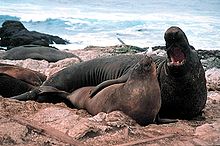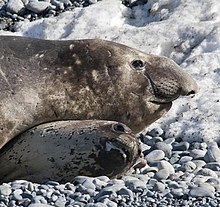
Back Olifantrob Afrikaans Sǣelpend ANG فيل البحر Arabic فيل البحر ARZ Spedol (Mirounga) AVK Dəniz fili Azerbaijani دنیز فیلی AZB Марскія сланы Byelorussian Морски слонове Bulgarian Gajah laut BJN
| Elephant seals | |
|---|---|

| |
| Male and female northern elephant seals | |

| |
| Male and female southern elephant seals | |
| Scientific classification | |
| Domain: | Eukaryota |
| Kingdom: | Animalia |
| Phylum: | Chordata |
| Class: | Mammalia |
| Order: | Carnivora |
| Clade: | Pinnipedia |
| Family: | Phocidae |
| Tribe: | Miroungini Muizon, 1981 |
| Genus: | Mirounga Gray, 1827 |
| Type species | |
| Phoca leonina | |
| Species | |
Elephant seals or sea elephants are very large, oceangoing earless seals in the genus Mirounga. Both species, the northern elephant seal (M. angustirostris) and the southern elephant seal (M. leonina), were hunted to the brink of extinction for lamp oil by the end of the 19th century, but their numbers have since recovered. They can weigh up to 4,000 kilograms (8,800 lb). Despite their name, elephant seals are not closely related to elephants, and the large proboscis or trunk that males have was convergently evolved.
The northern elephant seal, somewhat smaller than its southern relative, ranges over the Pacific coast of the U.S., Canada and Mexico. The most northerly breeding location on the Pacific Coast is at Race Rocks Marine Protected Area, at the southern tip of Vancouver Island in the Strait of Juan de Fuca. The southern elephant seal is found in the Southern Hemisphere on islands such as South Georgia and Macquarie Island, and on the coasts of New Zealand, Tasmania, South Africa, and Argentina in the Peninsula Valdés. In southern Chile, there is a small colony of 120 animals at Jackson Bay (Bahía Jackson) in Admiralty Sound (Seno Almirantazgo) on the southern coast of Isla Grande de Tierra del Fuego.[1]
The oldest known unambiguous elephant seal fossils are fragmentary fossils of a member of the tribe Miroungini described from the late Pliocene Petane Formation of New Zealand.[2] Teeth originally identified as representing an unnamed species of Mirounga have been found in South Africa, and dated to the Miocene epoch;[3][4] however, Boessenecker and Churchill (2016) considered these teeth almost certainly to be misidentified toothed whale (odontocete) teeth.[2] The elephant seals evolved in the Pacific Ocean during the Pliocene period.[2][5][6]
Elephant seals breed annually and are seemingly habitual to colonies that have established breeding areas.[7]
- ^ "WCS Chile > Especies > Elefantes marinos". programs.wcs.org. Retrieved 27 May 2016.
- ^ a b c Boessenecker, RW; Churchill, M (2016). "The origin of elephant seals: implications of a fragmentary late Pliocene seal (Phocidae: Miroungini) from New Zealand". New Zealand Journal of Geology and Geophysics. 59 (4): 544–550. Bibcode:2016NZJGG..59..544B. doi:10.1080/00288306.2016.1199437. S2CID 133343398.
- ^ Pickford, Martin; Senut, Brigitte (1997). "Cainozoic mammals from coastal Namaqualand, South Africa". Palaeontologia Africana. 34: 199–217. hdl:10539/16409.
- ^ Berta, A.; Churchill, M. (2012). "Pinniped Taxonomy: evidence for species and subspecies". Mammal Review. 42 (3): 207–234. doi:10.1111/j.1365-2907.2011.00193.x.
- ^ Rule, James P.; Adams, Justin W.; Rovinsky, Douglass S.; Hocking, David P.; Evans, Alistair R.; Fitzgerald, Erich M. G. (November 2020). "A new large-bodied Pliocene seal with unusual cutting teeth". Royal Society Open Science. 7 (11): 201591. Bibcode:2020RSOS....701591R. doi:10.1098/rsos.201591. ISSN 2054-5703. PMC 7735334. PMID 33391813.
- ^ Rule, James P.; Adams, Justin W.; Marx, Felix G.; Evans, Alistair R.; Tennyson, Alan J. D.; Scofield, R. Paul; Fitzgerald, Erich M. G. (11 November 2020). "First monk seal from the Southern Hemisphere rewrites the evolutionary history of true seals". Proceedings of the Royal Society B: Biological Sciences. 287 (1938): 20202318. doi:10.1098/rspb.2020.2318. PMC 7735288. PMID 33171079.
- ^ De Bruyn, Mark; Hall, Brenda L.; Chauke, Lucas F.; Baroni, Carlo; Koch, Paul L.; Hoelzel, A. Rus (2009). "Rapid Response of a Marine Mammal Species to Holocene Climate and Habitat Change". PLOS Genetics. 5 (7): e1000554. doi:10.1371/journal.pgen.1000554. PMC 2700269. PMID 19593366.